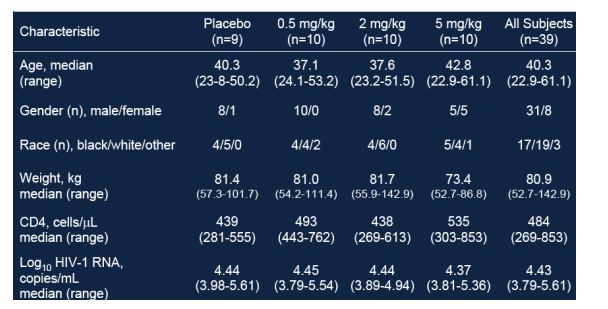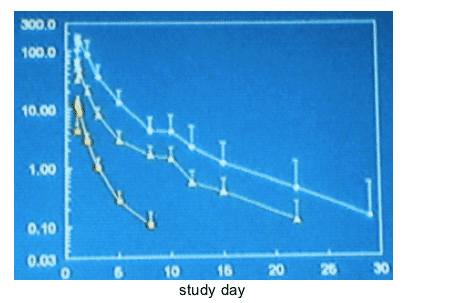 |
 |
 |
| |
Antiviral Effects and Tolerability of the CCR5 Monoclonal antibody PRO 140: A Proof of Concept Study in HIV-Infected Individuals
|
| |
| |
Jeff Jacobson for the PRO 140 1302 Study Team
One dose of PRO 140 was administered by infusion and the average viral load reduction was -1.70 to -1.83 log at day 10. The antiviral activity persisted for another 2-3 weeks at decreasing levels towards baseline. The next study will use subcutaneous injection. Dosing weekly and every 2 weeks subcutaneously "predicted to provide desired PRO 140 drug levels". PRO 140 rapidly coated CCR5 lymphocytes after drug administration and maximal coating durable for 1-2 weeks postdosing, concurrent with antiviral activity.
AUTHOR SUMMARY
PRO 140 was generally well tolerated: no drug-related SAEs; no dose-limiting toxicity.
There was potent, rapid, prolonged, dose-dependent significant antiviral activity: highest single-dose (1 dose of the drug was administered) viral load reductions reported (-1.83 log on average)
1 log or more reductions persisted after dosing
100% of patients receiving high dose of 5mg/kg had at least a 1 log reduction in viral load.
Antiviral activity was dose-dependent but not associated with baseline CD4, viral load
PRO 140: Humanized CCR5 Monoclonal AntibodyPRO 140: Humanized CCR5 Monoclonal Antibody
Broadly and potently inhibits wild-type and drug-resistant R5 HIV in vitro
Distinct class of CCR5 inhibitor
-Binds extracellular v. transmembrane site
-Inhibits HIV via competitive v. allosteric mechanism
-Inhibits HIV without blocking the natural activity of CCR5 in vitro
-Inhibits HIV resistant to small-molecule CCR5 antagonists
-Synergistic with small-molecule CCR5 antagonists
-Potential for improved tolerability without drug-drug or food interactions
Distinct patterns of resistance
Potential for infrequent dosing
Well tolerated in preclinical studies and in healthy volunteers
Designated FDA Fast Track drug candidate
Additional potential advantages of PRO 140
--Retention of CCR5's natural activity
--Improved tolerability without drug-drug or food interactions
--infrequent dosing
STUDY DESIGN
Objective: Examine the tolerability, antiviral activity, and PK of single-dose intravenous PRO 140 in HIV+ subjects. They think administration will ultimately be a subcutaneous injection. Next study will look at subcutaneous injection.
Randomized, double-blind, placebo-controlled study.
Eligibility: HIV RNA >5000; R5 virus only; CD4 >250; nadir CD4 >200; no AIDS-defining illness; no ART for 3 months.
39 Subjects.
Nominal doses: 0, 0.5, 2 and 5 mg/kg
Followup: 59 days
Study 1302, Baseline Characteristics
In the high dose 5mg/kg half of the patients were women. 10-30% of patients were HCV-positive. Prior ARV therapy ranged from 3-6. There were 4 blacks out of 10 in the high dose group.

SAFETY
--no drug-related serious adverse events.
--no dose-limiting activity
--no onbvious pattern of toxicity
--no difference relative to placebo in change in HIV co-receptor tropism
all subjects screened for R5-only virus
dual/mixed tropism result observed post-treatment in
-1/9 placebo patients (11%)
-1/30 PRO 140 subjects (3%; 0.5 mg/kg group)
Antiviral effects
--potent, rapid, prolonged, dose-dependent and highly significant single-dose activity: only one dose was administered.
--Mean viral load reductions:
-1.70 log at day 10 using high dose 5mg/kg.
-1.83 log for individual nadirs
The 2.0mg/kg dose reduced viral load by 1.05 log on average, and the lowest dose of 0.5mg/kg reduced viral load by a mean 0.3 log.
There was 1 patient for whom drug had no effect antiviral activirt or pharmacokinetics.
these are the largest single-dose reductions reported for any HIV drug
10-fold reductions:
--first seen at day 5
--persisted for 2-3 weeks post-dose


There was a trend towards increased CD4 cells at 5mg/kg: 129 cells (29%) average increase at day 8 (p=0.055) and levels remained elevated post-treatment for 3 weeks.
Viral Susceptibility (Monogram Sciences)
All viruses were susceptible to PRO 140 at baseline, with minimal variation:
--mean relative IC50 = 2.0 (range: 0.83-5.1)
--mean MPI = 99% (range: 93-100%)
No change in susceptibility post-treatment:
-- <2-fold change in rIC50 for all subjects
-- mean rIC50 = 2.1 (range: 0.98-4.71)
-- mean MPI = 99% (range: 93-100%)

PHARMACOKINETICS
Mean PRO 140 Serum Conc ug/mL
Yellow line - 0.5 mg/kg, line in the middle is 2/mg/kg, top line is 5mg/kg

Serum concentrations of PRO 140 and anti-PRO 140 antibodies measured by ELISA.
PK metrics assessed by non-compartmental analysis:
--peak and total exposure increased proportionately or better with dose. Peak levels were achieved in 3-60 minutes.
--terminal half-life of about 4 days.
Low titer antiPRO 140 antibodies developed in one subject (5mg/kg): no obvious effect on PK or antiviral response.
Coating of CCR5 Lymphocytes
Lymphocytes analyzed by flow cytometry ex vivo with fluorescently labeled:
--PRO 140
-- non-competing CCr5 antibody
No depletion of CCR5 lymphocytes.
Obvious coating of CCR5 lymphocytes by PRO 140.
Duration of coating maximal for 1-2 weeks and consistent with duration of antiviral effects.

Correlates of Efficacy
PRO 140 dose correlated with both:
--magnitude of viral load reduction (p=0.0001)
--duration of response (p=0.0059)
HIV RNA nadir reductions were independent of:
Baseline HIV RNA
Baseline CD4 count
Baseline CCR5 cells
Log Change in HIV RNA
In picture it says: Emax = -2.15 log; AUC60 = 44 mg'day/L
Yellow dot=0.5mg/day, next green triangle=2 mg/kg, last blue triangle=5/mg/kg

|
| |
|
 |
 |
|
|